Homeowners often face the frustrating reality of receiving an insurance estimate for roof repairs that far exceeds the actual cost of the work. This discrepancy, however, doesn’t mean you’re stuck paying more than necessary. By understanding the intricacies of insurance appraisals, negotiating effectively with contractors and insurers, and strategically documenting the repair process, homeowners can significantly reduce their out-of-pocket expenses.
This guide navigates the complexities of roof repair costs, empowering you to secure the best possible outcome.
This article provides a comprehensive breakdown of the factors that influence both insurance estimates and actual repair costs. We delve into the nuances of negotiating with insurance companies, choosing reputable contractors, and meticulously documenting the entire process. Learn how to identify hidden costs, leverage cost-effective repair solutions, and ultimately, ensure your roof is repaired efficiently and affordably, even if your insurance payout falls short of initial estimates.
Finding Cost-Effective Repair Solutions

Securing affordable roof repairs requires a proactive approach encompassing strategic negotiation, informed material selection, and diligent contractor vetting. Ignoring these steps can lead to significantly inflated costs, potentially exceeding insurance estimates even after negotiating a settlement. This section details effective strategies to mitigate expenses and achieve cost-effective solutions.Negotiating Lower Repair Costs with ContractorsEffective negotiation hinges on preparedness and a thorough understanding of market rates.
Before engaging with contractors, research average costs for similar repairs in your area. Websites like HomeAdvisor and Angi provide price benchmarks. Armed with this information, you can confidently challenge inflated quotes. Highlighting competitive bids from other contractors is a powerful negotiating tactic.
Furthermore, clearly outlining your budget constraints upfront can encourage contractors to propose cost-saving alternatives. Remember, politeness and a collaborative approach are crucial; a confrontational stance is rarely productive. Consider negotiating on aspects like the project timeline or payment schedule, potentially yielding discounts.
Roofing Material Price Comparison
The choice of roofing material significantly impacts the overall cost. Asphalt shingles remain the most budget-friendly option, while more durable materials like tile or metal command a higher price. The following table illustrates the price variations:
| Roofing Material | Cost per Square (100 sq ft) | Lifespan (Years) | Notes |
|---|---|---|---|
| Asphalt Shingles (3-Tab) | $70
|
15-20 | Economical, readily available |
| Asphalt Shingles (Architectural) | $120
|
25-30 | Enhanced durability and aesthetics |
| Tile (Clay or Concrete) | $150
|
50+ | Highly durable, fire-resistant, but heavier |
| Metal (Aluminum or Steel) | $200
|
50+ | Long lifespan, energy-efficient, but can be noisy |
Note: Prices are estimates and can vary significantly based on location, labor costs, and material availability.
Obtaining Multiple Quotes from Reputable Contractors
Soliciting multiple quotes is paramount to securing the best possible price. Begin by identifying at least three to five licensed and insured roofing contractors with positive online reviews. Ensure you provide each contractor with the same detailed scope of work, including specific repair requirements and desired materials.
Compare not only the total cost but also the breakdown of labor and material expenses. Verify licensing and insurance information independently to mitigate risks. Thoroughly review contracts before signing, paying close attention to payment schedules, warranties, and liability clauses.
Choosing a contractor solely based on the lowest price without considering their experience and reputation can prove costly in the long run.
Negotiating with Insurance Companies

Successfully navigating the insurance claim process after a roof repair is crucial for securing fair compensation. Many homeowners find the initial insurance estimate falls short of the actual repair costs. Effective negotiation strategies, supported by robust evidence, are essential to bridge this gap.Negotiating a higher insurance payout requires a proactive and well-documented approach.
This involves understanding your policy, gathering comprehensive evidence, and presenting a compelling case to the insurance adjuster. Appealing the initial estimate is often necessary, demanding patience and persistence.
Presenting Evidence to Support a Roof Repair Claim
Strong evidence forms the cornerstone of a successful negotiation. This includes detailed photographic documentation of the roof damage, pre- and post-storm images showing the extent of the damage, and a comprehensive report from a qualified roofing contractor. The contractor’s report should specify the necessary repairs, materials required, labor costs, and a detailed breakdown of the total estimated cost.
Furthermore, including copies of relevant permits and licenses adds credibility to your claim. Consider including weather reports from the date of the incident, corroborating the severity of the storm and its potential impact on your roof. A well-organized binder presenting all this information in a clear and concise manner is highly recommended.
Appealing an Insurance Company’s Initial Estimate
The appeal process typically involves submitting a formal letter outlining your disagreements with the initial assessment. This letter should clearly state the discrepancies between the insurance estimate and the contractor’s estimate, referencing the specific evidence provided. It’s crucial to maintain a professional and respectful tone throughout the correspondence.
Be prepared to provide further documentation or clarification if requested by the insurance company. If the appeal is unsuccessful, exploring mediation or seeking legal counsel may be necessary. For example, if the insurance adjuster fails to account for the cost of replacing specialized roofing tiles, a detailed explanation supported by quotes from suppliers and the contractor’s report can strengthen your appeal.
Similarly, if the adjuster underestimates the extent of the underlying structural damage, a structural engineer’s report would be a valuable addition to your appeal documentation.
Effective Strategies for Negotiating a Higher Insurance Payout
Several strategies can improve your chances of securing a more favorable settlement. First, thoroughly review your insurance policy to understand your coverage limits and the claims process. Second, obtain multiple estimates from reputable roofing contractors to demonstrate the reasonableness of your repair costs.
Third, maintain detailed records of all communication with the insurance company, including dates, times, and the names of individuals you interacted with. Fourth, be prepared to negotiate. Don’t be afraid to counter the insurance company’s offer with a well-supported justification.
Finally, be persistent and patient. The process may take time, but a well-documented and persuasive case significantly increases the likelihood of a successful outcome. For instance, if the insurance company initially offers a payout that covers only 70% of the contractor’s estimate, presenting a detailed breakdown of the remaining 30% – highlighting the cost of specific materials or the necessity of specialized labor – can increase the chances of a more equitable settlement.
Documenting Repair Process

Meticulous documentation is crucial in navigating roof repair, especially when dealing with insurance claims. A comprehensive record safeguards your interests and facilitates smooth communication with contractors and insurers. This detailed approach minimizes disputes and ensures you receive the appropriate compensation or services.Thorough documentation provides irrefutable evidence of the damage, the repair process, and the final outcome.
This detailed record serves as a valuable asset should any unforeseen issues arise later. The process should be systematic and thorough, covering all stages from initial assessment to final cleanup.
Pre-Repair Documentation
Before any work begins, thoroughly document the existing damage. This involves taking high-resolution photographs and videos from multiple angles, showcasing the extent of the damage. Include close-ups of affected areas, highlighting cracks, missing shingles, or water damage. Note the date and time on each image.
Additionally, create a detailed written description of the damage, noting the location and severity of each affected area. Consider using a grid system to map the damage on a roof plan, if available. For example, a photograph might show a large section of missing shingles on the south-facing slope, while a video might zoom in on a specific area of water damage inside the attic.
A written description might detail the approximate square footage of damaged areas and the type of damage observed.
During-Repair Documentation
Maintain a chronological record of the repair process itself. Take photographs at regular intervals, showing the progression of the work. This includes images of the removal of damaged materials, the installation of new materials, and the cleanup process. Document any unexpected issues encountered during the repair, along with the corrective actions taken.
For instance, images showing the removal of damaged underlayment and the installation of new roofing felt are crucial. A photograph documenting the correct disposal of debris according to local regulations is also essential. Keep detailed records of materials used, including brands, quantities, and any relevant certifications.
A photo of the delivery receipt or invoice for these materials would be beneficial.
Post-Repair Documentation
Once the repairs are complete, conduct a final inspection and document the results. Take photographs of the completed work from various angles, ensuring all areas are visible. Compare these images with the pre-repair photos to highlight the successful remediation of the damage.
Compile all documentation into a single, organized file. This includes photos, videos, written descriptions, invoices, receipts, and any communication with contractors or insurance adjusters. This organized collection will serve as a comprehensive record of the entire repair process.
Documentation Storage and Preservation
Organize all documentation in a clearly labeled, easily accessible location. Use a cloud-based storage system, such as Google Drive or Dropbox, for digital copies, ensuring adequate backup. For physical copies, store them in a waterproof, fire-resistant container. Consider creating a digital index of your documentation, categorizing it by date, type of document, and relevant details.
Regularly back up your digital files to prevent data loss. This comprehensive system ensures easy retrieval of your documentation, should the need arise in the future. For example, you might store high-resolution images on a cloud service and maintain a printed copy of the final inspection report in a fireproof safe.
Outcome Summary

Successfully navigating the often-turbulent waters of insurance claims and roof repairs requires a proactive and informed approach. By understanding the components of insurance estimates, effectively negotiating with both contractors and insurance providers, and diligently documenting every step, homeowners can significantly reduce their financial burden.
Remember, a thorough understanding of your policy, a well-chosen contractor, and a detailed record of the repair process are your strongest allies in achieving a fair and cost-effective solution. Don’t settle for an inflated estimate – take control of your roof repair.

